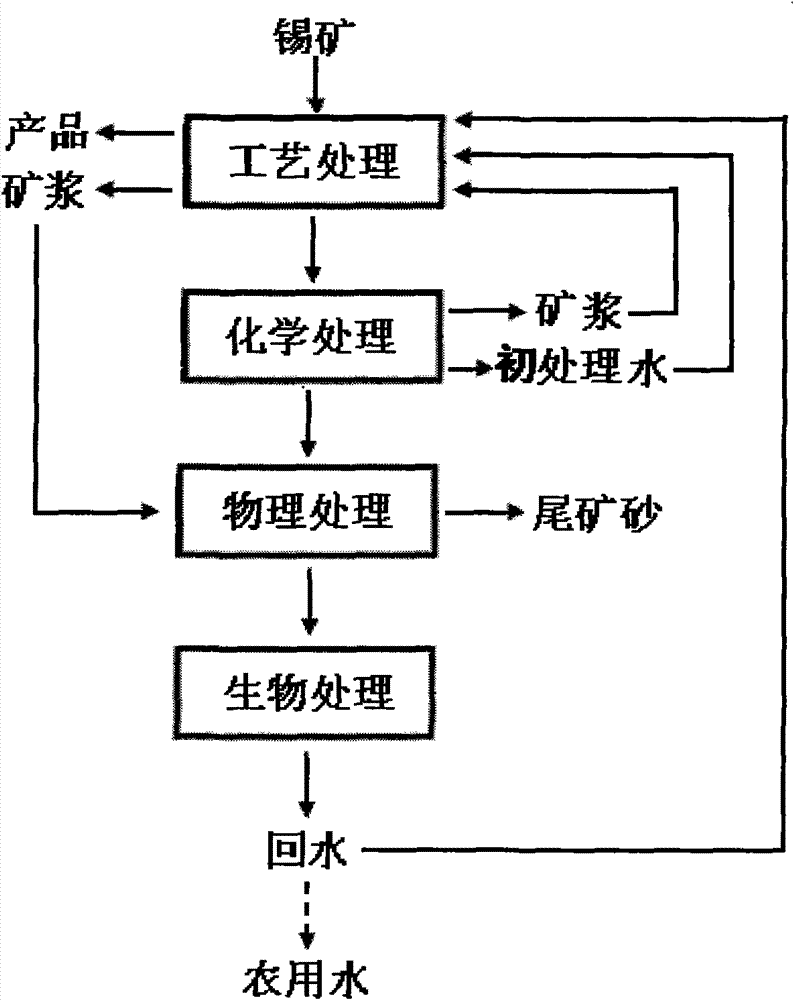Four-step method for processing and recycling tin ore floatation wastewater
A technology for mineral processing wastewater and treatment cycle, which is applied in energy wastewater treatment, water/sewage multi-stage treatment, water/sludge/sewage treatment, etc. It can solve the problem of unsatisfactory treatment effect of mineral processing wastewater, low processing cost and the influence of mineral processing indicators. The low utilization rate of backwater can reduce the content of pharmaceuticals and fine particles, improve the utilization rate of pharmaceutical components, and reduce the amount of production.
- Summary
- Abstract
- Description
- Claims
- Application Information
AI Technical Summary
Problems solved by technology
Method used
Image
Examples
Embodiment 1
[0032] In tin ore beneficiation, the combined flotation-magnetic separation-gravity separation technology is adopted. First, the high-efficiency heavy-separation waste disposal technology is used for ore beneficiation. The production rate is 30%, and the tailings with a particle size of 3~4mm and a tin grade less than 0.1% have realized the purpose of high-efficiency discarding, increased the content of tin metal entering the main process, and reduced the main process water and chemical consumption; Then apply selective grinding technology, and use different grinding media and different grinding strengths according to the tin ore of different grades and different particle sizes to reduce the over-crushing of tin ore, so that more than 70% of the metal can be re-selected The method is recovered, reducing the flotation load and the consumption of reagents, and the cassiterite recovery rate is increased to more than 65%; then the selective grinding technology is applied to the ultr...
Embodiment 2
[0034] In tin ore beneficiation, the combined flotation-magnetic separation-gravity separation technology is adopted. First, the high-efficiency heavy-separation waste disposal technology is used for ore beneficiation. The production rate is 30%, and the tailings with a particle size of 2~3mm and a tin grade of less than 0.1% have realized the purpose of high-efficiency waste disposal, increased the content of tin metal entering the main process, and reduced the main process water and chemical consumption; Then apply selective grinding technology, and use different grinding media and different grinding strengths according to the tin ore of different grades and different particle sizes to reduce the over-crushing of tin ore, so that more than 70% of the metal can be re-selected The method is recovered, reducing the flotation load and the consumption of reagents, and the cassiterite recovery rate is increased to more than 65%; then the selective grinding technology is applied to t...
Embodiment 3
[0036] In tin ore beneficiation, the combined flotation-magnetic separation-gravity separation technology is adopted. First, the high-efficiency heavy-separation waste disposal technology is used for ore beneficiation. The production rate is 30%, and the tailings with a particle size of 1~3mm and a tin content of less than 0.1% achieves the purpose of high-efficiency waste disposal, increases the content of tin metal entering the main process, and reduces the amount of water and chemicals used in the main process; Then apply selective grinding technology, and use different grinding media and different grinding strengths according to the tin ore of different grades and different particle sizes to reduce the over-crushing of tin ore, so that more than 70% of the metal can be re-selected The method is recovered, reducing the flotation load and the consumption of reagents, and the cassiterite recovery rate is increased to more than 65%; then the selective grinding technology is appl...
PUM
| Property | Measurement | Unit |
|---|---|---|
| thickness | aaaaa | aaaaa |
| thickness | aaaaa | aaaaa |
| thickness | aaaaa | aaaaa |
Abstract
Description
Claims
Application Information
 Login to View More
Login to View More - R&D
- Intellectual Property
- Life Sciences
- Materials
- Tech Scout
- Unparalleled Data Quality
- Higher Quality Content
- 60% Fewer Hallucinations
Browse by: Latest US Patents, China's latest patents, Technical Efficacy Thesaurus, Application Domain, Technology Topic, Popular Technical Reports.
© 2025 PatSnap. All rights reserved.Legal|Privacy policy|Modern Slavery Act Transparency Statement|Sitemap|About US| Contact US: help@patsnap.com


